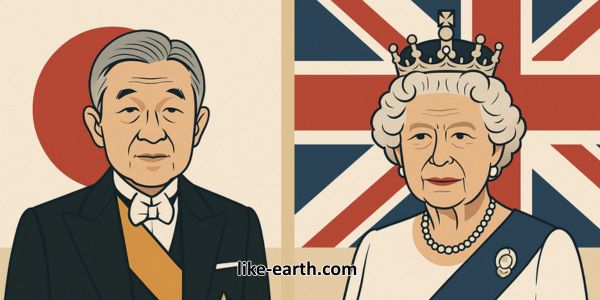Japanese Royal Family vs British Monarchy: A Tale of Two Traditions

Japanese Royal Family vs British Monarchy – Comparison of Japanese royal family and British monarchy reveals two of the world’s most enduring institutions. These monarchies represent vastly different cultural, historical, and political values, drawing global attention and sparking frequent discussions.
While both serve symbolic purposes, the way their roles unfold differs greatly. From protocols to public visibility, their traditions show how monarchy can mean entirely different things across continents.
Ancient Roots and Modern Transformations
The Japanese royal family, known as the Chrysanthemum Throne, traces its lineage back over 2,600 years. Emperor Jimmu, believed to be descended from the sun goddess Amaterasu, marks the origin of the world’s oldest hereditary monarchy.
In contrast, the British monarchy dates back over 1,000 years. Its formation resulted from conquest, civil war, and colonial expansion. Queen Elizabeth II’s reign symbolized continuity and modernity, while King Charles III now steps into a more transitional role.
Public Roles and Visibility
One key difference is the visibility of these monarchies. The British royal family is famously public-facing. They attend hundreds of events, support charities, and frequently engage with the media.
Conversely, the Japanese imperial family maintains a reserved presence. Public appearances are rare, and their traditional roles emphasize spiritual and cultural functions over social engagement. This stems from Shinto customs and post-war constitutional reforms.
Constitutional Duties and Limitations
Both monarchies are constitutional. However, the British monarch still meets weekly with the Prime Minister and formally appoints government officials. Despite this, political power remains ceremonial.
In Japan, the emperor’s duties are strictly defined by the constitution. Article 1 of the 1947 Japanese Constitution states that sovereignty resides with the people. The emperor’s role is entirely symbolic, even more so than his British counterpart.
Succession Rules and Gender Roles
The British royal family now practices absolute primogeniture, meaning the oldest child inherits the throne regardless of gender. This reform began with Princess Charlotte’s generation.
Japan, however, allows only male heirs from the paternal line to inherit. This creates succession concerns, as the pool of male heirs is shrinking. Princess Aiko, Emperor Naruhito’s only child, cannot inherit due to gender-based restrictions.
Media Representation and Public Scrutiny
Media exposure defines much of the British monarchy’s narrative. Documentaries, tabloids, and dramatizations like The Crown offer a constant stream of royal news, both factual and speculative.
The Japanese imperial family avoids such spotlight. Press coverage is tightly controlled, and imperial privacy is deeply respected. This reflects both cultural values and legal restrictions on reporting.
Cultural Identity and National Symbolism
In Japan, the emperor symbolizes unity, culture, and tradition. Ceremonies such as enthronements or New Year’s greetings emphasize this. Their presence offers continuity in a rapidly modernizing society.
In the UK, the royal family embodies national heritage and charity. Their weddings, births, and jubilees are celebrated globally, reinforcing a sense of national pride and soft power.
Financial Support and Public Opinion
The British royal family is funded through the Sovereign Grant, which comes from taxpayers. Public scrutiny of these finances is intense. Debate over their relevance and expenses is common in British discourse.
Japan’s monarchy is funded by state allowances, with less transparency. However, public support remains high. The Japanese respect the imperial role for its spiritual and traditional weight.
Scandals and Modern Controversies
The British monarchy often finds itself at the center of scandals. From Princess Diana’s interviews to Prince Andrew’s legal troubles, the family frequently makes headlines.
By contrast, Japanese royals maintain a scandal-free image. Yet, modern pressures exist. Princess Mako’s marriage to a commoner without state rituals caused media frenzy, leading her to give up royal status and move to the U.S.
Soft Power and International Influence
The British monarchy plays a global soft power role, especially among Commonwealth nations. Royal visits boost diplomacy and tourism.
Japan’s imperial family engages internationally with more caution. Their presence often fosters quiet diplomacy, especially in Asian relations. Emperor Akihito’s historical visit to China helped repair past tensions.
What the Future Holds
Both monarchies must adapt. Younger royals face new expectations from digital-age audiences. The British family walks a tightrope between tradition and transparency. The Japanese must address succession and relevance in a changing society.
Nonetheless, each monarchy continues to influence culture, politics, and identity. Their paths, though parallel, reflect distinct civilizations and values.
Conclusion
The comparison of Japanese royal family and British monarchy highlights fascinating contrasts in power, culture, and public life. Despite differences, both serve as enduring icons of tradition and national pride.
As the world changes, how they evolve will remain a subject of intense observation and global discussion.
For more engaging articles on cultural identity and global tradition, visit our main site.
Join the conversation and stay updated through our official WhatsApp channel. Japanese Royal Family vs British Monarchy



